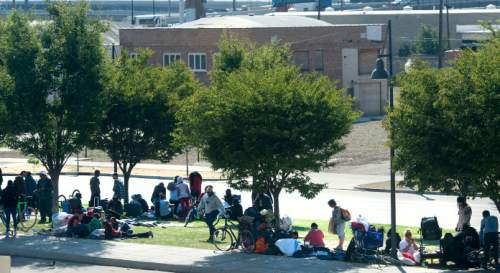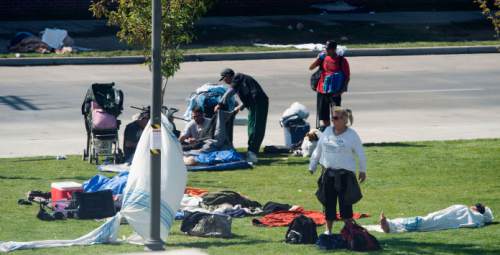This is an archived article that was published on sltrib.com in 2016, and information in the article may be outdated. It is provided only for personal research purposes and may not be reprinted.
Police officers assaulted. Homeless people unable to access welfare services. Drug dealers hiding out by the shelter.
By the grim picture he paints of the Rio Grande district in downtown Salt Lake City, it's clear to Jason Mathis: This is a "crisis."
"That's not hyperbole," said the member of the Salt Lake Chamber of Commerce and executive director of Downtown Alliance on Thursday. "That's not an exaggeration."
For Mathis, the "lawless chaos" along 500 West between 200 South and 400 South is a problem that's grown more violent and will continue to escalate until political leaders are held "accountable for solving this."
"You might think I am talking about Syria," he said in an email to The Salt Lake Tribune. "I'm not. I'm talking about our capital city."
In the past month, a slew of criminal activity has occurred in those two blocks adjacent to The Gateway. Three Salt Lake City police officers were assaulted in the area while responding to separate incidents during a three-hour period Tuesday morning, and a 54-year-old man was stabbed in the chest later that evening.
That follows an Aug. 28 report of a man who was shot and killed while driving near the intersection of 500 West and 300 South; a mob of people allegedly stripped the victim of weapons and belongings before police arrived. Eleven days before that, a machete-wielding man attacked and injured two people near the downtown homeless shelter, nearly severing a man's ear.
Though those accounts seem to suggest higher reports of crime concentrated in the area, SLCPD Detective Greg Wilking would have a "hard time categorizing it as a crisis." He believes those stories offer a limited snapshot of crime in the city, and that the area's cases are declining in frequency.
Statistics posted on SLCPD's site show officers responding to fewer total offenses in Salt Lake City Council District 4 — which includes the Road Home shelter — in June and July of this year when compared to the same months in 2015, but the difference is slight. For instance, there were 2,651 offenses there in June 2015; in June 2016, there were 2,462.
That trend doesn't hold for other months, and there is no general decline in offenses: There were about 40 more cases generated in the district in July than in June this year, and the department averages about 2,500 offenses per month, with little deviation, since January 2015.
June and July — the most recent months for which data are available — may have seen small declines from the same months in 2015, Wilking said, because crime is going down or officers are not taking as much action — for example, stopping people who have warrants from felony offenses and not from misdemeanor offenses.
SLCPD data does, however, show that officers use force in that district more than other Salt Lake City areas, though population size for each of the seven districts is about the same. There is not a breakdown of the addresses within the district where officers used force, but District 4 accounts for about 50 percent of the total use-of-force cases in Salt Lake City.
The zone around the downtown shelter is "an area we are focused on," Wilking said, and the department staffs the neighborhoods with patrol cars and bike police, which Chief Mike Brown brought back in late 2015 after a brief hiatus from the area. The number of officers in the zone varies based on the time and day of the week, with more staffing on Fridays and Saturdays, though Wilking would not provide specific figures.
A large part of the problem, Wilking said, is a shelter-area drug trade that is booming and creating an "unfortunate" situation for homeless people seeking services.
"It's not a good situation," he said, noting that people have "been getting more aggressive."
People should not avoid the area any more than other places in Salt Lake City, Wilking said, but they should be aware of their surroundings.
Mathis applauds the police presence in the area, but he says it's not enough. He calls for "concerted efforts" at the city and county levels to address what he believes is a dire and dangerous situation.
The Salt Lake County Health Department, Mathis said, stopped cleaning near the shelter for a month because of "safety concerns and a lack of funding." When crews returned to clean the camps last week, he added, the tires of their vehicles were slashed. At least three businesses have relocated from the area out of fear, Mathis said, of the "deteriorating" conditions.
Though he commends efforts to add more lights and portable restrooms near the shelter, Mathis called out the City Council, Salt Lake City Mayor Jackie Biskupski, the County Council, Salt Lake County Mayor Ben McAdams, SLCPD and Salt Lake County Sheriff's Office to work together toward an expedited solution.
"It's not just one entity's job to fix it," Mathis said, adding: "The time to solve it is now."
The City Council this week issued a news release that echoed Mathis' concern of a crisis: "Council members called for a plan from Mayor Biskupski in preparation for how the city will address emergency services this winter, and responding to the crisis conditions along 500 West and the Rio Grande/Pioneer Park area."
The city is working to find suitable locations to build two new shelters to draw people away from the Rio Grande district, said Matthew Rojas, Biskupski's spokesman. The Legislature designated $27 million in an effort to fight homelessness; part of those funds will be allocated to the Salt Lake City structures.
Biskupski acknowledges that there is "tons of room for improvement" with the homeless population, Rojas says, but the spokesman called the new shelters a "game changer" for the downtown area. The city hopes to narrow down to five its options on shelter locations by the beginning of October, with a commission presenting the final two selections to the council by Nov. 1.
In the meantime, the city hopes to "normalize" the space and "encourage people to go down there," Rojas said, by hosting events at Pioneer Park near the shelter, such as the Downtown Farmers Market and Twilight Concert Series.
ctanner@sltrib.com Twitter: @CourtneyLTanner













